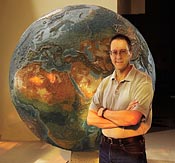UW’s computing research prowess brings Microsoft to Madison
Microsoft, the world’s largest computer software company, will open an advanced development laboratory in Madison later this spring, helping expand on a highly productive 20-year research and alumni relationship between the company and the University of Wisconsin–Madison computer sciences department.
The Microsoft Jim Gray Systems Lab, named in honor of the Microsoft executive who was a founding father of the database industry, will open in downtown Madison under the direction of UW–Madison emeritus computer sciences professor, and Microsoft Technical Fellow, David DeWitt, one of the world leaders in database research.

David DeWitt, one of the world leaders in database research and an emeritus computer sciences professor, will direct the new Microsoft Jim Gray Systems Lab.
Photo: Bob Rashid
The development lab not only adds a prestigious name to Wisconsin’s technology company portfolio, it will establish a unique academic partnership with UW–Madison that directly supports graduate education in computer sciences.
"Microsoft is here because we are doing some of the best database work in the world and we have produced scores of graduates who have gone on to successful careers in the industry," says DeWitt. "Our focus will be on continuing the production of talented graduate students and taking on some of the great challenges in database systems."
The company will open its West Main Street office with six full-time employees, and Microsoft has made a commitment to support a number of graduate research assistantships in the department, beginning this fall. DeWitt anticipates that the partnership will also provide internships to UW–Madison students and consulting opportunities for other UW–Madison faculty.
DeWitt emphasizes that this is just the beginning of the Madison presence. "We have high expectations for the lab and believe it will expand in size and scope over the coming years. This will allow us to keep more talent in Madison and potentially attract other technology companies."
Adds Gurindar Sohi, chair of the UW–Madison computer sciences department: "Creating a facility of this kind around a faculty member and a research group at a university is a very rare occurrence for Microsoft. From Madison’s perspective, it will be the first time a Fortune 100 company has established a presence in the city to directly tap into the talent coming from the university."
Gary Sandefur, dean of the College of Letters and Sciences, says he is especially excited about the opportunity this partnership provides graduate students.
"These students will have the chance to work in a real-world research and development program for one of the world’s leading software companies — that kind of experience is priceless in a field like computer science," Sandefur says. "While this is a great recruiting tool for Microsoft in the long run, we also see this helping UW–Madison recruit the highest quality graduate students and faculty."
According to Sohi, the lab will open a new chapter in a story that started three decades ago, when the department shifted from a mathematical focus to a systems research environment that would later produce a steady string of practical advances in commercial computers. The next significant chapter began in the late 1970s, when the university invested in a team of database researchers just as the nascent technology was beginning to transform computing.
The biggest development came when DeWitt’s research group launched the Gamma Parallel Database System Project in 1984, which produced most of the core technologies in commercial use today by companies such as IBM, NCR Teradata, Netezza, Greenplum, Vertica and Microsoft. The key innovation was what DeWitt calls a "divide and conquer" strategy that enabled computers to distribute queries across hundreds of processors, greatly expanding the ability of computers to handle massive database functions quickly and efficiently.
"This chapter would not have been written without the strong support of the state of Wisconsin and the university over the years, support that included catch-up raises at key times to help retain this talented group of faculty," Sohi adds.
The next generation of database research should be equally exciting, DeWitt says.
"In recent years, we’ve seen a transition from using hundreds of computers for managing massive data sets to using thousands or even tens of thousands of computers working in parallel," says DeWitt. "Many leading software vendors, including Microsoft, are exploring this technology for both their own applications and for end users."
The lab will initially work with other members of UW–Madison’s database team, including professors Jeffrey Naughton, Raghu Ramakrishnan, AnHai Doan and their students. But the lab may expand into other system research areas in the future.
William Barker, a Letters and Science associate dean; Ben Griffiths, a UW–Madison attorney; and staff of the Wisconsin Alumni Research Foundation (WARF) were instrumental in developing the agreement with Microsoft that addresses intellectual property, licensing and academic freedom issues. The intellectual property derived directly from the lab will belong to Microsoft, but the students involved in the program will retain the right to freely use the research results in an academic setting.
Barker says the computer sciences department will create an application process for graduate students interested in the project and nominate the top candidates. Microsoft will fully support the cost of research assistantships for participating students.
These graduate positions will function like any other at UW–Madison, where a major professor oversees the student’s research, helps establish goals and monitors progress. Sandefur will create an oversight committee that will ensure the students’ academic goals are complemented and strengthened by their relationship with Microsoft.
The naming of the lab after Microsoft executive Jim Gray is a very fitting honor, Sohi says, since Gray had a close relationship with the Madison research team and was a generous benefactor to the department.




